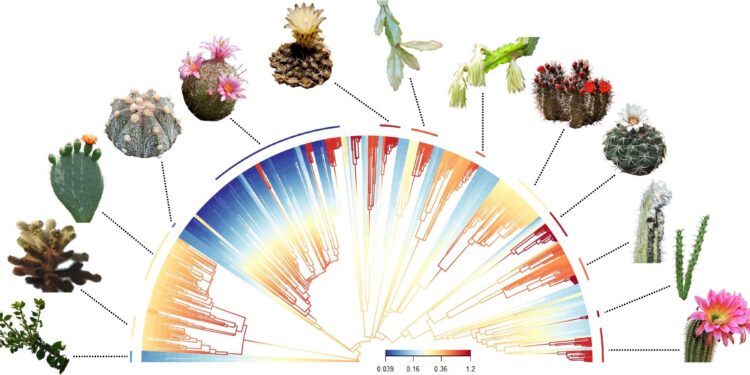Remarkable heterogeneity of diversification rate among Cactaceae. Credit: Nature Communications (2024). DOI: 10.1038/s41467-024-51666-2
Cacti are among the most diverse plants, from the giant saguaro cactus that can grow up to 18 metres tall, to the tiny button cactus that is just a few centimetres tall. A new study from the Milner Centre for Evolution at the University of Bath has helped to unravel the mystery of species diversity.
The work is published in the journal Nature Communications.
It was previously thought that climate dryness played a major role in cactus diversity, but researchers have found that this is not the case. The new study found that temperature variations throughout the day, soil sand content and seasonal changes are the main drivers of evolution.
Although they are popular houseplants around the world, cacti are native only to North, Central and South America, with the greatest species richness found in Mexico.
Researchers gathered all known published data on cacti to better understand the driving forces behind the enormous diversity of cactus species found today and constructed the largest evolutionary tree ever created for cacti using thousands of DNA sequences.
The team studied a wide range of biological variables, such as plant size, soil sand content, geographic distribution, aridity and diurnal temperature range (the minimum and maximum temperatures observed over 24 hours). They correlated these data with biodiversity and the rates of evolution of new species.
They used machine learning methods to model interactions between multiple variables simultaneously, then validated the results using traditional evolutionary methods.
Surprisingly, they found that although the greatest number of species was found in Mexico, the country also had the lowest rates of evolution of new species (speciation).
Aridity was previously thought to be a major factor in their evolution, but the new study suggests that diurnal temperature range, soil sand content and seasonality are more important drivers of evolution.
First author Dr Jamie Thompson carried out the research at the Milner Centre for Evolution in the Department of Life Sciences at the University of Bath and is now a lecturer at the University of Reading.
He said: “Cacti are a very interesting and diverse family of plants that have evolved relatively recently in evolutionary time to live in a wide variety of environments across the American continents. People think they are very resilient because they are able to live in extreme climates, but in fact they are more at risk of extinction than other types of plants.
“Because Mexico is the most biodiverse country, it was thought that the conditions were best for species to evolve. However, our study shows that this is not the case. On the contrary, Mexico has the slowest speciation rate, but it has high biodiversity, because extinction rates are slower. In other words, the Mexican climate is not necessarily more conducive to the production of new species, but it is good for preserving existing ones.”
Dr Nick Priest, Senior Lecturer at the Milner Centre for Evolution in the Department of Life Sciences at the University of Bath, said: “Our work shows that cacti are not doing as well as we thought and are more vulnerable to climate change. This is worrying: if cacti can’t thrive in our changing climate, what chance do other plants have?”
More information:
Jamie B. Thompson et al., Identifying multiple drivers of cactus diversification, Nature Communications (2024). DOI: 10.1038/s41467-024-51666-2
Provided by the University of Bath
Quote:From smooth, button-sized cacti to spiky, giant-sized cacti, why are they so diverse? (2024, August 28) Retrieved August 28, 2024 from
This document is subject to copyright. Apart from any fair dealing for the purpose of private study or research, no part may be reproduced without written permission. The content is provided for informational purposes only.



